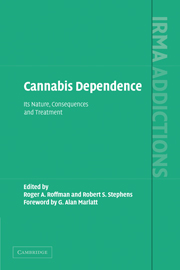Book contents
- Frontmatter
- Contents
- List of Contributors
- Acknowledgments
- Executive Summary
- Foreword
- Part I The Nature of Cannabis Dependence
- 1 Themes in the History of Cannabis Dependence
- 2 The Diagnosis of Cannabis Dependence
- 3 Understanding the Pharmacology and Physiology of Cannabis Dependence
- 4 The Epidemiology of Cannabis Dependence
- 5 The Adverse Health and Psychological Consequences of Cannabis Dependence
- Part II Interventions with Cannabis-Dependent Adults
- Part III Interventions with Cannabis-Dependent Adolescents and Young Adults
- Part IV Policy
- Part V Conclusion
- Index
4 - The Epidemiology of Cannabis Dependence
from Part I - The Nature of Cannabis Dependence
Published online by Cambridge University Press: 29 October 2009
- Frontmatter
- Contents
- List of Contributors
- Acknowledgments
- Executive Summary
- Foreword
- Part I The Nature of Cannabis Dependence
- 1 Themes in the History of Cannabis Dependence
- 2 The Diagnosis of Cannabis Dependence
- 3 Understanding the Pharmacology and Physiology of Cannabis Dependence
- 4 The Epidemiology of Cannabis Dependence
- 5 The Adverse Health and Psychological Consequences of Cannabis Dependence
- Part II Interventions with Cannabis-Dependent Adults
- Part III Interventions with Cannabis-Dependent Adolescents and Young Adults
- Part IV Policy
- Part V Conclusion
- Index
Summary
Introduction
This chapter describes selected features of cannabis epidemiology, with a focus upon recent evidence from field studies of cannabis dependence. An epidemiologist's interest in cannabis can be motivated by an appreciation that cannabis smoking represents the most common illegal drug use behavior in the world, with a roughly estimated 140–150 million cannabis users, as compared to rough estimates of 14–15 million for cocaine and 13–14 million for opium, heroin, and other opioid drugs (United Nations, 2002). Based upon recent estimates, projections, and averages for the USA, an estimated 7000–8000 individuals start using cannabis every day and there are 95 million US community residents who have tried cannabis on at least one occasion (Substance Abuse and Mental Health Services Administration, Office of Applied Studies (SAMHSA), 2002c, d). As will be documented later in this chapter, our rough averaged estimate is that some 50–80 recent-onset cannabis users develop a cannabis dependence syndrome each day during the year; some substantial fraction of these cases appear to require clinical intervention services.
It is generally possible to dissect epidemiological research in relation to five general rubrics or sub-headings. The first rubric concerns quantification of disease burden, including the burdens associated with mental and behavioral disturbances that do not qualify as formal diseases, as well as the population-averaged “incidence” and individual-level risk of becoming a cannabis user, and the separately estimated population-averaged “prevalence” and individual-level likelihood of being an active or former cannabis user (e.g., see Anthony & Van Etten, 1998, Wu, et al., 2003, for detailed discussions of the distinctions between incidence and prevalence).
Keywords
- Type
- Chapter
- Information
- Cannabis DependenceIts Nature, Consequences and Treatment, pp. 58 - 105Publisher: Cambridge University PressPrint publication year: 2006
- 45
- Cited by



